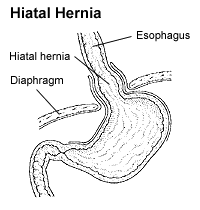Did you know?
You can double click on a word to look it up on TermGallery.
You can double click on a word to look it up on TermGallery.
Meanings of hiatal hernia in English
Portuguese
hérnia de hiato 
Hernia resulting from the protrusion of part of the stomach through the diaphragm.
Usage of hiatal hernia in English
1
An endoscopy was done demonstrating a hiatal hernia, and five benign polyps.
2
Its relief rate and adverse rate were influenced by hiatal hernia and drinking.
3
Gastric acid secretion was assessed by endoscopic gastrin test, and the presence of hiatal hernia by endoscopy.
4
A Nissen sleeve was performed due to its GERD, hiatal hernia and multiple polyps on the stomach.
5
Since he had a large sliding esophageal hiatal hernia that was increasing in size, he underwent laparoscopic fundoplication.
6
Background: Current literature is characterized by a discrepancy between reported symptomatic and radiological recurrent hiatal hernia's following primary repair.
7
The most common type is an axial hiatal hernia with incidence of 94.58%.
8
The size of a hiatal hernia was typically reported in a subjective fashion and only infrequently was the type specified.
9
Six occult umbilical hernias, 1 inguinal hernia, and 1 hiatal hernia were noted on endoscopic exploration.
10
Conclusions: Increased acid secretion after H. pylori eradication is an important risk factor of reflux oesophagitis, especially in patients with hiatal hernia.
11
After excluding patients undergoing concomitant hiatal hernia repair or fundoplication, there were 22,870 patients with 6-month follow-up.
12
Three patients with a giant hiatal hernia were treated by a simultaneous thoraco-laparoscopic approach, which proved to be technically feasible and safe.
13
Age, body mass index, size of the initial hiatal hernia, and sex had no significant effect on whether a patient developed a recurrence.
14
The aim of this trial is to analyze 1-year outcome of laparoscopic hiatal hernia repair using sutures versus sutures reinforced with non-absorbable mesh.
15
Conclusion: N-sleeve is a feasible and safe alternative in obese patients with reflux and hiatal hernia when Roux-en-Y gastric bypass it is not indicated.
16
Hiatal hernia is a frequent finding during upper gastrointestinal endoscopy.

